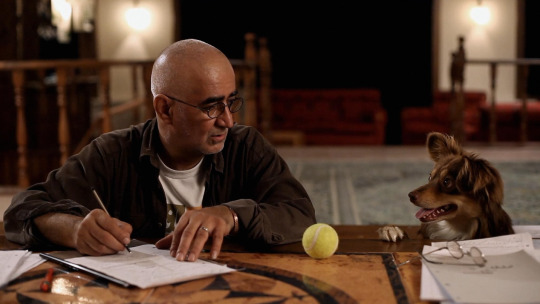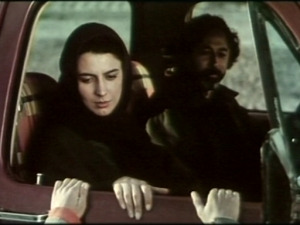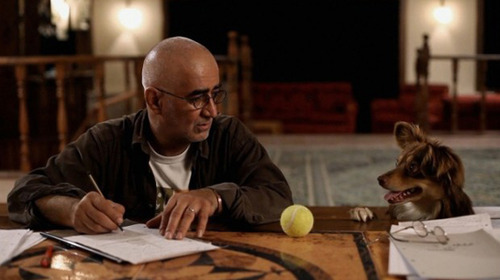#Kambuzia Partovi
Explore tagged Tumblr posts
Text

Closed Curtain directed by Jafar Panahi
7 notes
·
View notes
Photo








The Deserted Station (2002)
On a pilgrimage to Mashad from Tehran, a couple's transportation breaks down, far from any major town. The husband, a photographer, seeks help at a nearby village and encounters a teacher who offers to help. Whilst the husband and teacher go off to find a spare part, the wife, who used to be a teacher, takes over the teaching lessons in the village. It is clear that the children live there, in this strange deserted place, without any men, save the teacher and an old signal guard. As the day draws on, the children help to bring a new hope and life into the wife's heart.
Scripted by Kambuzia Partovi (based on a story by Abbas Kiarostami).
#The Deserted Station#Iran#Iranian cinema#Persian#Abbas Kiarostami#Kambuzia Partovi#Leila Hatami#Persian films#Iranian films#Iran cinema#Arabian cinema#cinema#filmmaking#old films#must see films#recommended movies#films to watch#underrated films#hidden gems#hiddengem films#hidden gem film#underrated#A Separation#Tehran#Motherhood#pregnancy#children
95 notes
·
View notes
Photo



Closed Curtain , Jafar Panahi , 2013.
#closed curtain#jafar panahi#maryam moqadam#kambuzia partovi#pardé#2013#film#edit#iran#iranian cinema
36 notes
·
View notes
Photo



پرده [Closed curtain] (Jafar Panahi - Kambuzia Partovi, 2013)
#پرده#Closed curtain#Jafar Panahi#Panahi#Kambuzia Partovi#Partovi#2013#2010s movies#2010s cinema#2010s#Persia#Cinema of Persia#Iran#Cinema of Iran#cinema#Iranian filmakers#Iranian film directors#Iranian New Wave#censorship#censorship in Iran#Islamic censorship in Iran#Islamic censorship#dogs#cruelty#Islamic rules#Maryam Moqadam#Middle East#Iranian government#Islamic Republic of Iran
15 notes
·
View notes
Photo

Closed Curtain
directed by Jafar Panahi and Kambuzia Partovi, 2013
0 notes
Link
Eleven short animated movies have been selected to be screened, while nine short films from across the world will be competing in the festival, which will be held online from October 18 to 23 this year due to a spike in coronavirus cases in the country.
“Butterflies” by Elizaveta Khlomova from Russia is a highlight of the lineup for the animation competition.
In “Butterflies”, two girls wake up and start to play a game. Using their vivid imaginations, they create their own world out of nothing and fly up, up and away.
“Hello, My Dears” is another Russian animation by Alexander Vasiliev competing in this category.
The animation is about an elderly lady who loves her dear relatives in the portrait photos on display in the living room. Looking out the window, one by one, the relatives from the photos come out and act as they please on the bench or the ground. Their actions seem somewhat strange, but that’s a reflection of who they really are. This simple animation, which unfolds alongside Chopin’s piano piece, gives a deep sense of compassion, love and nostalgia.
“Hugo & Holger” has been selected from Denmark. Directed by Teddy Halkier Kristiansen, the animation tells the story of Hugo, who is always dreaming about getting a dog. He is overjoyed when he meets a baby elephant named Holger, thinking he’s a big puppy dog.
Swedish filmmaker Jons Mellgren’s “Elsa and the Night” will also be screened in this section.
Elsa is afraid to sleep. Actually, she has not slept a wink for thirty years. Early one morning when she’s sitting at the kitchen table, she finds an unwelcome guest underneath her sofa. The creature turns out to be none other than the Night itself. Elsa tells it of her life, and her best friend – an elephant named Ola as the Night accompanies her on a moving journey.
Iranian director Maryam Kashkulinia’s acclaimed animation “The Eleventh Step” has been selected to be screened in the festival.
The animated film has been produced based on children’s writer Susan Taqdis’s story “The Eleventh Step” that is about a lion cub that never dared to take one more step toward its freedom when the zookeeper forgot to lock the door to its cage.
The lineup for the international short animation competition also includes several other movies from France, Belgium, Germany and Iran.
The short fiction film competition features films from Germany, the Netherlands, Italy, Finland, Spain and Iran.
“Boje” by Andreas Cordes and Robert Köhler from Germany is a highlight of the lineup.
Boje and his father live in a remote cottage by the sea, with no one but each other. While the boy longs for answers and the father struggles for words, suddenly the silence between them is penetrated by the waves of a choppy sea. Answers magically find their way to Boje – as father and son find a way to talk.
“Good Girl”, a co-production of Estonia, Finland, Italy and Portugal by Merja Maijanen is also competing in the event.
In the film, a naive little girl, after being awarded for being a good girl, learns what it really means to be one.
The festival is co-organized by the Farabi Cinema Foundation (FCF) and Isfahan Municipality.
FCF director Alireza Tabesh, who is also the director of the festival, said on Tuesday that the event’s platforms will provide free access for everybody to watch all the movies competing in the various categories.
Ebrahim Foruzesh, director of the acclaimed movies “The Water Urn” and “Key”, and Kambuzia Partovi, co-writer of Majid Majidi’s film “Muhammad, the Messenger of God”, are scheduled to receive lifetime achievement awards.
Photo: A poster for “Boje” by Andreas Cordes and Robert Köhler from Germany that will be competing in the short competition of the 33rd International Film Festival for Children and Youth.
MMS/YAW
1 note
·
View note
Text
عرض فيلم محمد رسول الله
عرض فيلم محمد رسول الله
متابعة شهد عادل نشرت قناه ATV على صفحتها الرسمية عبر موقع التواصل الاجتماعي لتداول الصور والفيديوهات “الانستجرام”فيديو ترويجي لفيلم محمد رسول الله معلقا عليه يوم الجمعة الساعة 21.30 على ATV. محمد رسول الله هو فيلم ملحمي إيراني إسلامي لعام 2015 من إخراج ماجد مجيدي وشارك في كتابته Kambuzia Partovi ، تدور أحداث الفيلم في القرن السادس حول طفولة النبي محمد . والجدير بالذكر ان فيلم محمد رسول الله من…

View On WordPress
0 notes
Text
Muhammad : The Messenger Of God (2015)

Negaraku Indonesia Muhammad : The Messenger Of God (2015)
Tentang Film Muhammad: The Messenger of God
Muhammad: The Messenger of God adalah sebuah film epik Islam Iran 2015 yang disutradarai oleh Majid Majidi dan ditulis bersama dengan Kambuzia Partovi. Film tersebut berlatar belakang abad keenam dimana sebuah kisah bercerita tentang masa kecil nabi Islam Muhammad. Film tersebut menjadi produksi berbiaya terbesar dalam sinema Iran pada saat ini.
Pengembang Film Majidi pada tahun 2009
Pengembangan Muhammad: The Messenger of God dimulai pada 2007 dan Majidi menulis bagian pertama dari permainan latar-nya pada 2009. Pada 2011, sebuah set kolosal dibuat di kota Qom dekat Tehran yang disiapkan untuk kebanyakan adegan dalam film tersebut. Beberapa adegan difilmkan di Amerika Selatan. Pada saat proses pemfilman, Majidi bekerja dengan sebuah tim sejarawan dan arkeolog untuk karya tentang akurasi kehidupan awal Nabi Muhammad. Pengerjaan pasca-produksi dimulai di Munich pada akhir 2013 dan selesai pada 2014. Sinematografi-nya dirampungkan oleh Vittorio Storaro dan skor film-nya dikomposisikan oleh A. R. Rahman.
Tayangan Perdana 1 Februari 2015
Film tersebut direncanakan tayang perdana di Festival Film Internasional Fajr pada 1 Februari 2015 namun tidak jadi karena kesulitan teknikal. Untuk para kritikus, pembuat film dan jurnalis, sebuah penayangan istimewa diadakan di Cinema Farhang, Iran pada 12 Februari 2015. Film tersebut dirilis di Iran serta di Festival Film Dunia Montreal pada 27 Agustus 2015. Film tersebut terpilih sebagai entri Iran untuk Film Berbahasa Asing Terbaik di Academy Awards ke-88.
Pemeran The Messenger Of God (2015)
Mahdi Pakdel (sebagai Abu Talib)
Sareh Bayat (sebagai Halimah)
Alireza Shoja Nouri (sebagai Abdul Muttalib)
Mohsen Tanabandeh (sebagai Samuel)
Dariush Farhang (sebagai Abu Sufyan)
Siamak Adib (sebagai Hanatte)
Seyed Sadegh (sebagai Hatefi)
Mina Sadati (sebagai Aminah)
Mohammad Asgari
Ra’na Azadivar
Sadegh Hatefi

Muhammad : The Messenger Of God (2015) Negaraku Indonesia
from Negaraku Indonesia https://ift.tt/3K8Gpcd
0 notes
Text
Nabi Muhammad | The Messenger of God Movie
Nabi Muhammad | The Messenger of God Movie
Nabi Muhammad: The Messenger of God adalah sebuah film epik Islam Iran 2015 yang disutradarai oleh Majid Majidi dan ditulis bersama dengan Kambuzia Partovi. Film tersebut berlatar belakang abad keenam dimana sebuah kisah bercerita tentang masa kecil nabi Islam Muhammad.
Film atau movie tersebut menjadi produksi berbiaya terbesar dalam sinema Iran pada saat ini. Pengembangan Muhammad: The…
View On WordPress
0 notes
Photo

پرده [Closed curtain] (Jafar Panahi - Kambuzia Partovi, 2013)
#پرده#Closed curtain#Jafar Panahi#Panahi#Kambuzia Partovi#Partovi#2013#2010s movies#2010s cinema#2010s#Persia#Cinema of Persia#Iran#Cinema of Iran#cinema#Iranian filmakers#Iranian film directors#Islamic censorship in Iran#censorship in Iran#Iranian New Wave#censorship#Maryam Moqadam#Islamic rules#Islamic censorship#life#Islamic Republic of Iran#Middle East#Iranian government#memories
1 note
·
View note
Text
Closed Curtain

In Closed Curtain, Panahi has moved past only talking about his story ideas. The film opens in a well-constructed diegesis about a scriptwriter (Partovi) and his dog, but halfway through the film, Panahi suddenly appears. The curtains are figuratively and literally drawn, and the story deconstructs the stability of the world it's been establishing as well as Panahi's own psychological stability as a filmmaker; he can only take a few steps into a narrative before his impulse for self-reflexivity and self-doubt kick in. Instead of compromising the material at hand, this fourth-wall breakdown adds a layered sophistication missing from Panahi's previous productions.
The film isn't only self-reflexive, but also self-referential, opening and closing with static long takes of a barred window of a beach house. This framing is virtually identical to the immobile shots of a barricaded entrance of a jewelry store that open and close 2003's Crimson Gold. The bars in both films—slender, elegant, and suffocatingly encompassing the wide cinematic frame—allude to the cognitive imprisonment of its characters. In Closed Curtain, that includes Panahi himself, but initially it's Partovi's scriptwriter, who arrives at the beach house with the nervous air of a man on the run. Once inside the safe confines of the large, empty house, the writer unzips a duffel bag to reveal an adorable, small dog named Boy. The writer is particularly concerned with Boy's safety and won't let him outside to pee—a strange restriction that makes sense once he turns on the television to show broadcasts of a public dog ban, which Boy watches disconsolately with his nose buried underneath the couch cushion. The ban, a religious decision based on the Islamic idea of cleanliness, seems allegorical, but it's sadly very much rooted in reality. In Iran, dogs are regularly rounded up and euthanized, and owners no longer risk taking their beloved pets outside.
Despite his anxiety over Boy's whereabouts, the Writer seems mostly at peace in the solitude of his beach house, though his decision to pin up black curtains over thin white ones already covering the windows seems excessive. Suddenly a young man, Reza (Hadi Saeedi) and his sister, Melika (Maryam Moqadam), appear at the door, urgently in search of refuge from the authorities. They counter the Writer's suspicions about their motives with their own questions about his runaway status; it appears the Writer may also be a fugitive, but their terse trade-offs are largely ambiguous about the characters' respective circumstances. Soon, Reza leaves to find a car, putting the apparently suicidal Melika in the Writer's care, but after annoying him she leaves without a trace, only to magically reappear again the next day inside the house. Agitated by these developments, the Writer creates a safe space where he and Boy can hide, which he uses the next day when his house sounds like it's being ramshackled by unknowns.
It soon becomes apparent that if these characters are on the run from anything, it's from their own reality. These are phantoms, not fully formed characters, figments from the shattered mind of their creator. When Panahi appears in the frame, initially seen in a mirrored shot as he pulls down curtains that reveal posters of his previous films, illuminating that this is likely his own house, he has the same rigid, tense air as the Writer, and given their similarities (the fact that the character is played by the co-director and is living out his kind of house arrest), Partovi's character is obviously a stand-in for Panahi himself.
Panahi walks around and tears off curtains and then makes tea for himself, pouring a few extra cups; now that he's alone in the house, it's uncertain who the cups are for. Neighbors visit and ask about the broken glass, and are tasked with replacing it, and their presence is jarring: Are they in the reality in which Panahi is making the movie, or are they in a separate diegesis altogether? The neighbors leave, the characters reappear, and then leave again. Panahi makes tea once again. Is the tea for the neighbors or for the characters? The film never answers these questions, or why or how Panahi is able to move from the world inhabited with his characters to the allegedly real one containing his neighbors.
Closed Curtain uses Panahi's beach house to create a metaphysical reality in which he appears as much a political prisoner in his real life as he does within his creative world; the fantastical escape offered to him by his characters' diegesis seems both restrictive and enticing. Melika invites him in a recorded iPhone video to follow him into the water to kill himself; she disappears into the ocean in the video, and we soon watch him start recording a video where he does the same. The film then rewinds the footage and he reappears, dry and unharmed. In Iranian postmodern art, the symbolic use of natural objects and places is an important motif in underscoring the sojourns of its characters, and there are few natural elements more symbolically powerful than the warm, seductive immersion of the ocean. Panahi's symbolic journey won't end with drowning waters, but in Closed Curtain he articulates exactly how warm and enticing the waters can be.
1 note
·
View note